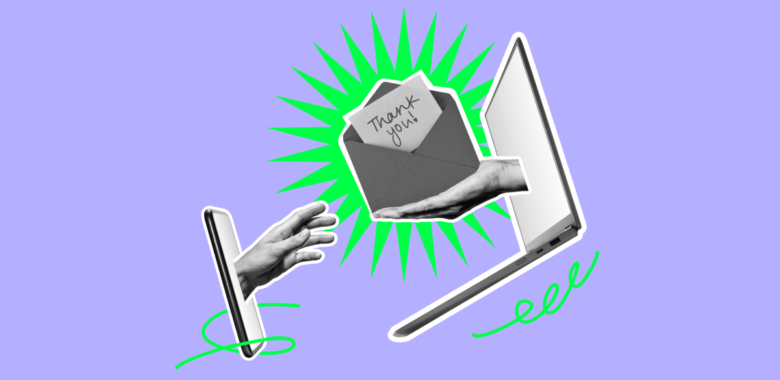How to write a professional thank-you email
Let’s break down the structure of a thank-you email and discuss what should be in each element from a subject line to a sign-off.
Subject line
The subject line is an important element in your email, which affects whether your email will be opened or not. Keep it clear and simple, and make sure to mention what you are thankful for.
Here are some examples of subject lines for professional thank-you emails:
- Thank you for your purchase.
- Thank you for your support.
- Thank you for choosing us.
In principle, these subject line templates work for any situation you might be in: job interviews, events, etc.
Greeting
The greeting of your thank-you email sets the tone for your message. Choose an appropriate greeting based on your relationship with the recipient.
Here are some examples of greetings:
- Dear [First name]: a formal greeting suitable for both professional and casual emails.
- Dear Mr./Ms. [Last name]: can be used if you want to maintain a high level of formality and respect.
- Hello/Hi [First name]: suitable for professional and casual emails you may send to a colleague.
- Dear [Company name] team: good for situations when, for example, you’ve had a job interview with several people at once and you’re sending a thank-you email to a company’s address like [email protected].
- Hello/Hi/Hey [Company name] team: same as above but informal, use if appropriate.
Body
In the body of the email, personalize your message and tell the recipient why exactly you’re thanking them. If you only write in generic expressions of gratitude with no detail, it won’t look genuine. Here’s an example:
| Don’t ❌❌❌ |
Do ✔️✔️✔️ |
| I’m dropping you a thank you note for everything you’ve done to us. |
I’m dropping you a thank you note for everything you’ve done on this project. I especially appreciate your great help with developing our blog and our outreach strategy. Your contribution to the content plan for the next quarter and your banner placement study were especially valuable. |
But what if you’re sending a thank-you email to a customer? For example, someone who’s been loyal to your company for many years. A good period to do that is at the start of a new year for the business. For instance, your Happy New Year email could also include words of appreciation. Should you go into heavy detail here? Here’s how to do it:
| Don’t ❌❌❌ |
Do ✔️✔️✔️ |
| Our team is thankful for your support. |
Thank you for staying with us and using our email marketing app for promotion during all these 4 long years. Our team would appreciate your feedback as it will contribute to our product development greatly. |
Sign-off
You might think that two thank-yous (in the subject line and your main message) are enough. And we are here to disappoint you — it isn’t! Sprinkle a little gratitude in the end, especially if your message was long. Let’s review some examples of how to end the thank-you email:
- Thanks again. Looking forward to collaborating with you in the future.
- Thank you for your consideration. I would be excited to continue our partnership.
- Thanks for your consideration in advance. I’d be happy to hear any feedback from you.
- Thanks for your dedication. It was a pleasure to discuss this project with you.
- Thanks again. Cheers to more projects together!
To make your email even better, use one of the nice and warm sign-off phrases, like:
- Sincerely
- Kind regards
- Many thanks
- Best wishes
- With sincere thanks
- With gratitude
- Warm regards
- Many thanks
- Regards
Note that the sign-offs vary in formality — for example, “Sincerely” and “Regards” are on the more formal side, while “Best wishes“ are more informal. Choose the sign-off that corresponds to the general tone of voice you use in the email.
Signature
Let’s be clear: yes, you can put your name as a signature and call it a day (e.g. “Best regards, John”). That is if the recipient knows exactly who you are. But in any other case — so pretty much in most of them — it’s better to use the signature in full. For a personal email account, include your full name and contact information. For a professional one, add to that your job title or role, company name, and details (like a link to the website and physical address).
Let’s look at the example of what our “Best regards, John” will turn into in the professional email:
| John Smith
Marketing Manager
ABC Company
123 Main Street, New York
Phone: (123) 456-7890
Email: [email protected] |
Many email clients and software platforms offer the option to set up an automated signature to be attached to your outgoing emails. This feature helps to achieve consistency in your email communications and save time by not having to manually type your signature each time you send an email. You can also use third-party email signature generators like MySignature.







